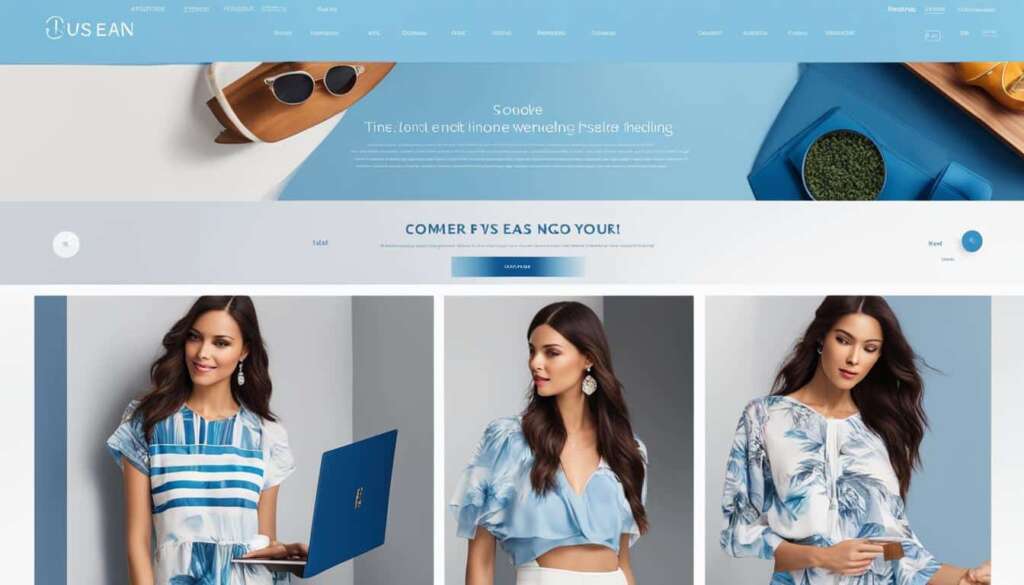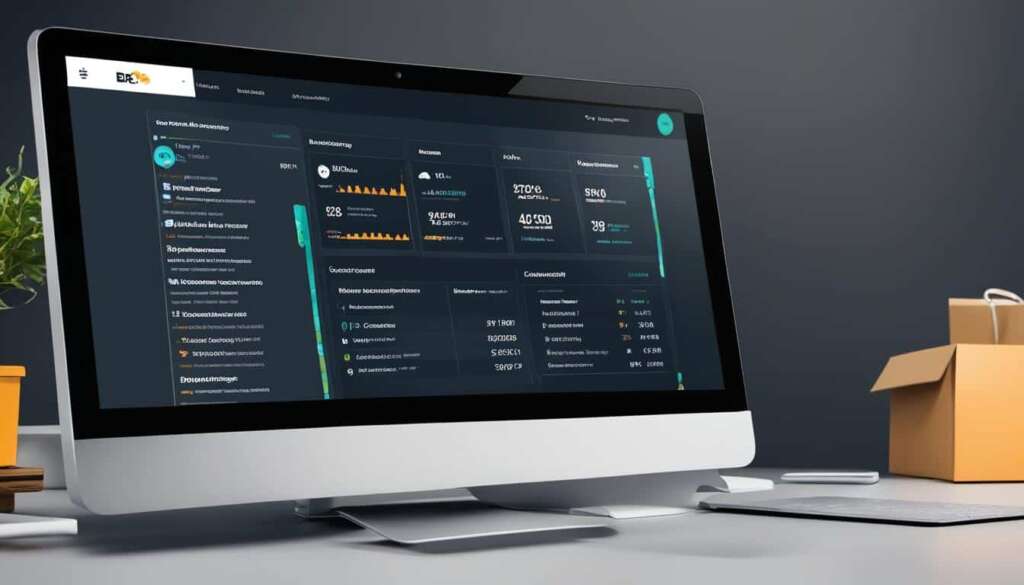Table of Contents
Welcome to our article on e-commerce landing page design. If you’re looking to boost your online sales and maximize conversions, you’ve come to the right place. Landing pages play a crucial role in capturing visitors’ attention, keeping them engaged, and enhancing their overall shopping experience on your e-commerce website.
But what exactly is an e-commerce landing page and how is it different from a product page? In this article, we will explore the definition of an e-commerce landing page, its purpose, and the key differences between landing pages and product pages. We’ll also discuss why landing pages are essential for your e-commerce site and provide you with best practices for creating high-converting landing pages.
Are you ready to take your e-commerce business to the next level? Let’s dive in and discover the secrets to successful e-commerce landing page design.
What is an Ecommerce Landing Page?
An ecommerce landing page, also known as a standalone web page, is specifically designed for marketing purposes. It serves as the first page that visitors “land” on when they click on a link, such as an advertisement or promotion. The main objective of an ecommerce landing page is to guide customers towards completing a specific goal, such as making a purchase.
Unlike other pages on an ecommerce website, landing pages are created to be personalized and highly engaging. They are tailored to match the buyer’s intent and are optimized to increase click-through rates and conversions. Ecommerce landing pages feature compelling content, high-quality images, and clear call-to-action buttons that direct visitors towards the desired action.
Key Features of an Ecommerce Landing Page
- Engaging Content: Ecommerce landing pages are designed to capture visitors’ attention and keep them engaged. They present a clear value proposition and communicate the benefits of the product or service.
- High-Quality Images: Visuals play a crucial role in ecommerce landing pages. They help showcase the product or service in an appealing manner, enhancing the overall user experience.
- Clear Call-to-Action Buttons: Ecommerce landing pages feature prominently placed call-to-action buttons that guide visitors towards completing the desired action. These buttons are strategically designed to stand out and encourage click-through.
The primary focus of an ecommerce landing page is to convert visitors into customers. By providing a seamless, personalized experience that aligns with the buyer’s intent, ecommerce businesses can maximize their chances of driving conversions and increasing sales.
| Benefits of Ecommerce Landing Pages | Role in Marketing Strategy |
|---|---|
| Improved customer targeting | Increased click-through rates |
| Higher conversion rates | Enhanced user experience |
| Reduced bounce rates | Maximized sales potential |
Differences Between Ecommerce Landing Pages and Product Pages
E-commerce landing pages and product pages serve different purposes and have distinct designs. While product pages provide detailed information about a specific product, landing pages are specifically optimized for conversion rate optimization. Let’s explore the key differences between these two types of pages.
-
Product pages: These pages are designed to showcase a specific product and provide in-depth information about its features, specifications, and pricing. They are typically part of an e-commerce website and serve as individual pages for each product. Product pages can include multiple call-to-action buttons, navigation links, and additional product recommendations. The primary goal of a product page is to inform and educate potential customers about a particular product.
-
Landing pages: In contrast, landing pages are standalone web pages specifically created for conversion goals. They are designed to direct targeted audiences to take a specific action, such as making a purchase or filling out a form. Landing pages usually have a single, clear call-to-action that guides visitors towards the desired goal, such as “Buy Now” or “Subscribe”. By removing distractions and focusing on the content most relevant to the buyer’s journey, landing pages increase the likelihood of conversion.
In summary, while product pages provide comprehensive information about a particular product, landing pages are optimized for conversion rate optimization. Landing pages target specific audiences, provide a more personalized experience, and have a singular call-to-action that guides visitors towards conversion.
Example:
“The landing page for our latest smartphone release focuses on highlighting its cutting-edge features and includes a prominent call-to-action button to encourage immediate purchase. On the other hand, the product page provides a comprehensive overview of the smartphone’s specifications, customer reviews, and pricing options while offering various call-to-action buttons for visitors to explore different purchase options.”
Why You Need Landing Pages For Your Ecommerce Site
Landing pages are essential for e-commerce sites as they play a crucial role in the sales funnel. They bridge the gap between ad campaigns and making a purchase, driving higher ROI for paid traffic. By directing visitors to landing pages that match their expectations, you can increase the likelihood of conversion and avoid wasting ad spend.
Landing pages are also great for testing different marketing strategies and targeting specific customer segments. They provide a better experience for visitors, ensuring they find the information and offers they are looking for, ultimately increasing conversions.
The Importance of the Sales Funnel
Before understanding why landing pages are necessary for your e-commerce site, it’s important to grasp the concept of the sales funnel. The sales funnel represents the journey that customers go through, from their initial awareness of your brand to becoming a paying customer. It consists of different stages, each requiring specific marketing approaches to guide prospects toward conversion.
At the top of the funnel, you have the awareness stage, where potential customers become aware of your brand and products. This stage is often fueled by paid traffic, such as online ads or social media campaigns. However, simply driving traffic isn’t enough. You need to ensure that these visitors are directed to landing pages that cater to their needs and expectations.
Maximizing ROI with Targeted Landing Pages
When visitors land on a relevant landing page that speaks directly to their needs, they are more likely to engage with your brand and take the desired action. This could be making a purchase, signing up for a newsletter, or filling out a lead form.
By implementing targeted landing pages, you can maximize your return on investment (ROI) for your paid traffic. Instead of driving all your traffic to generic product pages, which may not meet the specific needs of different customer segments, you can create landing pages that are tailored to each segment.
For example, if you have a clothing e-commerce site, you can create separate landing pages for men, women, and children, showcasing relevant products and messaging. This level of personalization and relevance increases the chances of conversion, as visitors feel they are being catered to.
Testing and Optimizing for Higher Conversions
Landing pages also provide a valuable opportunity for testing and optimizing your marketing strategies. You can experiment with different headlines, images, layouts, and call-to-action buttons to see which combination drives the highest conversions.
A/B testing is a common method used to compare two versions of a landing page to determine which performs better. By continuously testing and optimizing your landing pages, you can fine-tune your marketing efforts and improve your conversion rates over time.

Targeting Specific Customer Segments
Lastly, landing pages enable you to target specific customer segments more effectively. By understanding the different needs and preferences of your various customer segments, you can design landing pages that cater to each group.
For instance, if you offer premium products and services, you can create a landing page specifically for high-income individuals who value quality and exclusivity. On the other hand, if you have budget-friendly options, a landing page targeting price-conscious shoppers can showcase affordable products and highlight discounts.
By tailoring your landing pages to specific customer segments, you provide a more personalized experience that resonates with their needs and aspirations, increasing the chances of conversion.
In conclusion, landing pages are integral to the success of your e-commerce site. They facilitate the sales funnel, drive higher ROI for paid traffic, allow for testing and optimization, and enable targeted marketing to specific customer segments. By investing time and resources into creating effective landing pages, you can boost conversions, maximize sales, and take your e-commerce business to new heights.
Conclusion
In conclusion, e-commerce landing page design plays a pivotal role in boosting conversions and maximizing sales for your online business. By implementing best practices and creating well-crafted landing pages that align with your marketing objectives, you can create a seamless and compelling customer journey that leads to increased conversions.
When it comes to e-commerce landing page design, clear and concise messaging is essential. Your landing page should immediately communicate the value proposition and benefits of your products or services. Captivating visuals that showcase your offerings can grab visitors’ attention and help create a memorable brand experience.
Strong call-to-action buttons are crucial for guiding visitors towards making a purchase or taking a desired action. The placement, color, and wording of your call-to-action buttons can significantly impact click-through rates and conversions. Additionally, personalizing your landing page content based on different customer segments can enhance the overall user experience and increase the likelihood of conversions.
By following these best practices and continually testing and optimizing your e-commerce landing pages, you can elevate your online business, attract more customers, and achieve sustainable growth. Remember, a well-designed and strategically crafted landing page can make all the difference in capturing visitors’ attention, building trust, and ultimately driving them to become loyal customers.
FAQ
What is an e-commerce landing page?
An e-commerce landing page is a standalone web page created specifically for marketing purposes. It is the page that a visitor “lands” on when they click on a link, such as an advertisement or promotion.
How are e-commerce landing pages different from product pages?
E-commerce landing pages are optimized for conversion goals, while product pages provide information about a specific product. Landing pages have one clear call-to-action, targeted audiences, and a personalized and focused experience.
Why do I need landing pages for my e-commerce site?
Landing pages play a crucial role in the sales funnel, driving higher ROI for paid traffic and increasing the likelihood of conversion. They also allow for testing different marketing strategies and targeting specific customer segments.







